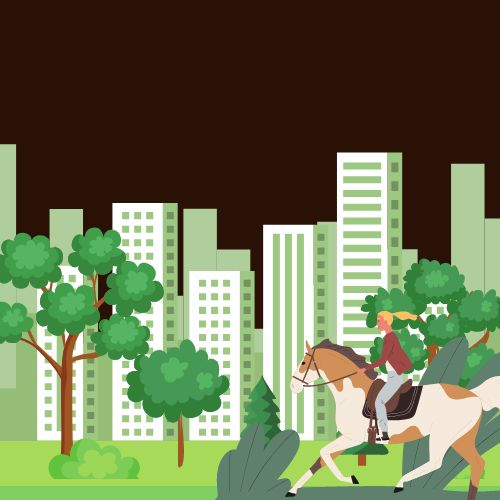INTRODUCTION
Our lifestyle habits and health outcomes are profoundly shaped by the communities and neighborhoods in which we live and spend time every day. The “built environment” refers to man-made surroundings such as buildings, parks, transportation systems, and other infrastructure that provide the physical framework for communities. Research shows the built environment has a significant influence on our ability to make healthy choices regarding diet, physical activity and general wellness.
TABLE 1: KEY FACTS ABOUT THE BUILT ENVIRONMENT AND HEALTHY LIFESTYLES
- People living in walkable neighborhoods with good access to parks and recreational facilities are 46% more likely to meet physical activity recommendations than those living in the least walkable areas (CDC, 2020).
- Over 60% of Americans live in neighborhoods that lack basic amenities to support healthy lifestyle behaviors such as walking (RWJF, 2021).
- Urban sprawl has contributed to a 21% increase in obesity rates in the U.S. since 1990 (MacDonald, 2010).
- Building more sidewalks is associated with increased rates of walking and higher overall physical activity levels (Frost et al., 2010).
- Access to healthy foods is lacking in many low-income urban and rural communities, contributing to poor diets and health outcomes (Ver Ploeg et al., 2009).
This article will explore how aspects of the built environment like transportation options, urban design, access to recreation/nature, and availability of nutritious foods can support or undermine healthy behaviors. Specific strategies communities are using to design healthier environments will also be highlighted. The goal is to illustrate how modifying the built surroundings we interact with daily could help nudge populations towards more active, social and nutrition-minded lifestyles.
TRANSPORTATION AND URBAN DESIGN
Transportation networks and urban design patterns have profound consequences for physical activity levels according to multiple studies. Sprawling, car-centric development encourages sedentary commuting and discourages utilitarian walking like trips to the store or school. Compact, mixed-use neighborhoods with interconnected street grids make active transportation much more appealing and practical.
Some key findings related to transportation and urban design:
- Walkable, mixed-use development with a high “intersection density” is linked to 25-90% higher non-work physical activity levels (Sallis et al., 2009).
- For each additional hour spent in a car daily, risk of obesity increases by 6% (Frank et al., 2004).
- Retrofitting cul-de-sacs with pathways increased walking rates in one study by 65% (Southworth, 2005).
- Communities designed prioritizing pedestrians see 25-100% more walking than those focused on cars (Ewing & Cervero, 2010).
To encourage more physical activity through transportation, community leaders are implementing strategies like:
- Expanding and connecting sidewalk and trail networks to provide safe walking routes.
- Improving bicycle infrastructure with protected lanes, bike racks and trails.
- Incentivizing public transit use and carpooling through smart growth policies.
- Implementing traffic calming measures in neighborhoods like road diets, speed bumps and roundabouts.
- Zoning for mixed-use development focused around town centers rather than isolated commercial strips.
ACCESS TO RECREATION AND NATURE

Access to quality recreational facilities and natural areas provides opportunities for social and family-oriented physical activity. Green spaces and trails have also been linked to numerous mental health benefits. Yet many communities lack adequate recreation infrastructure to support active living.
Research has found:
- Living near parks and recreational facilities increases adults’ odds of meeting exercise guidelines by 26% (Cohen et al., 2007).
- Having more neighborhood green space reduces obesity risk by roughly 5% (Lachowycz & Jones, 2011).
- Less park access in disadvantaged neighborhoods contributes to lower activity levels (Wolch et al., 2011).
Some remedies communities are adopting to improve access to recreation and nature include:
- Developing new neighborhood and pocket parks, especially in underserved areas.
- Investing in multi-use trail networks linking residential areas to key destinations.
- Preserving and better utilizing existing open space like schoolyards, wetlands and stream corridors.
- Advocating for more tree canopy coverage along streets and public spaces.
- Creating recreational programming that welcomes a diversity of populations.
AVAILABILITY OF HEALTHY FOODS

Nutritious food access is another social determinant of health heavily influenced by community design patterns. A food environment with abundant fast and processed options but scarce healthy alternatives can undermine dietary health and wellness. Yet many residents live in “food deserts” devoid of supermarkets or farmers’ markets.
Research shows:
- Each additional supermarket in a census tract is associated with a 32-49% reduction in obesity risk (Morland et al., 2002).
- For every additional convenience store, obesity rates rise by 1.3-2.2% (Morland et al., 2006).
- Lack of transportation impedes food access for 1 in 8 Americans (Ver Ploeg et al., 2009).
To cultivate healthier local food environments, some strategic approaches include:
- Attracting grocery stores and farmers’ markets to underserved areas through incentives.
- Developing community agriculture programs on vacant lots for fresh local produce.
- Promoting mobile markets and delivery services to improve accessibility.
- Implementing nutrition standards in corner stores to expand healthy options availability.
- Zoning for mixed-use development incorporating retail with residences.
- Educating residents on budget-friendly healthy eating and cooking techniques.
COMMUNITY HEALTHY LIVING INITIATIVES
Many communities are now directly coordinating initiatives to comprehensively improve public health through environmental and policy changes. These systemic efforts frequently employ a community-centered approach of engagement, education and empowerment.
Some successful strategies seen across the U.S. involve:
- Forming citizen task forces to study health issues and make built environment recommendations.
- Passing Complete Streets policies mandating road design accommodate all travel modes.
- Implementing Safe Routes to School infrastructure projects enabling kids to walk/bike to class.
- Launching public awareness campaigns promoting active transportation and local healthy options.
- Developing partnerships between municipal departments and health organizations.
- Securing grant funding and forming public-private collaborations to support new programs.
- Hosting community workshops, classes and social events centered around wellness themes.
- Passing zoning regulations incentivizing pedestrian-friendly and mixed-use developments.
FAQs:
- What is the built environment?
The built environment refers to the human-made surroundings in which we live, work, and play. It encompasses the physical structures, infrastructure, and spaces that make up our communities, including buildings, roads, parks, transportation systems, and public amenities.
- How does it affect health behaviors and outcomes?
It can impact health behaviors and outcomes.
- What strategies can be used to design healthier built environments?
Strategies for designing healthier built environments include promoting active transportation, increasing access to green spaces, creating mixed-use developments, improving healthy food options, prioritizing safety and inclusivity, incorporating environmental sustainability, and engaging the community.
CONCLUSION
The evidence clearly demonstrates the built environment has profound impacts on our ability and motivation to make healthy choices daily. Disrupting sedentary transportation and urban design patterns with greater mobility infrastructure could open doors for more active living. Expanding access to recreational and natural areas encourages leisure physical activity and social support networks integral for holistic wellbeing. Cultivating local food environments with more grocery and farmers’ market access is key for nourishing communities with nutritious dietary options.
By incorporating proven urban planning, transportation and health strategies into a coordinated community-level initiative, local governments can take important steps towards supporting healthier lifestyles through improved built surroundings. A well-designed environment that makes the easy choice the healthy choice holds immense potential for enhancing public health and quality of life for generations to come.

